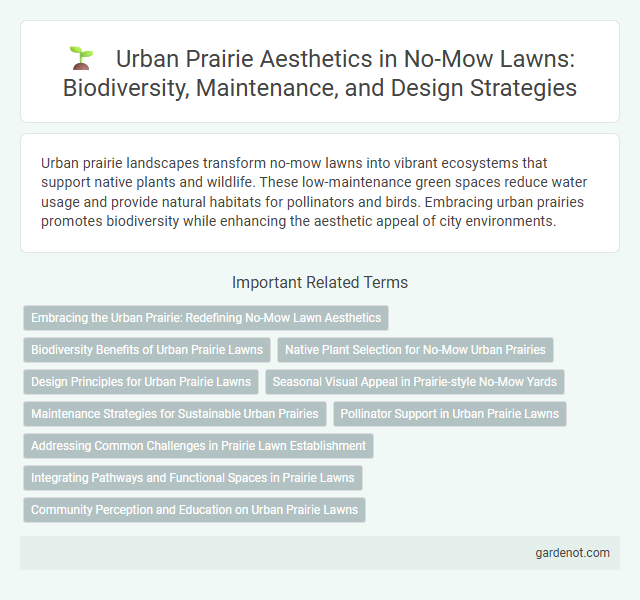Urban prairie landscapes transform no-mow lawns into vibrant ecosystems that support native plants and wildlife. These low-maintenance green spaces reduce water usage and provide natural habitats for pollinators and birds. Embracing urban prairies promotes biodiversity while enhancing the aesthetic appeal of city environments.
Embracing the Urban Prairie: Redefining No-Mow Lawn Aesthetics
Urban prairie landscapes transform no-mow lawns into vibrant ecosystems that support biodiversity and create natural habitats in city environments. Native grasses and wildflowers replace traditional turf, fostering pollinators and reducing maintenance while enhancing soil health. This ecological approach redefines lawn aesthetics by blending sustainability with urban beauty, promoting greener, low-impact green spaces.
Biodiversity Benefits of Urban Prairie Lawns
Urban prairie lawns significantly enhance biodiversity by providing habitat for native pollinators, such as bees, butterflies, and birds, which support urban ecosystem health. These no-mow areas foster diverse plant species, improving soil quality and promoting natural pest control in city environments. Increased biodiversity in urban prairies also contributes to greater resilience against climate change and helps maintain ecological balance within metropolitan landscapes.
Native Plant Selection for No-Mow Urban Prairies
Native plant selection for no-mow urban prairies emphasizes drought-tolerant species like purple coneflower (Echinacea purpurea), little bluestem grass (Schizachyrium scoparium), and black-eyed Susan (Rudbeckia hirta). These plants enhance biodiversity by providing habitats for pollinators such as bees and butterflies, while requiring minimal irrigation or maintenance. Incorporating native grasses and wildflowers supports sustainable urban landscapes that reduce lawn mowing frequency and promote ecological resilience.
Design Principles for Urban Prairie Lawns
Urban prairie lawns embrace native grasses and wildflowers to create sustainable, low-maintenance landscapes that promote biodiversity in city environments. Design principles include selecting drought-tolerant, pollinator-friendly plant species, zoning for layered height and texture, and fostering natural growth patterns to reduce mowing frequency. These lawns support urban wildlife habitats while enhancing soil health and minimizing water usage, making them ideal for eco-conscious urban planners.
Seasonal Visual Appeal in Prairie-style No-Mow Yards
Urban prairie no-mow yards showcase vibrant seasonal visual appeal through native grasses and wildflowers that transition beautifully from spring blooms to golden autumn hues. These prairie-style landscapes support biodiversity while requiring minimal maintenance compared to traditional lawns. Their dynamic textures and colors create year-round interest, enhancing urban green spaces with natural aesthetics.
Maintenance Strategies for Sustainable Urban Prairies
Urban prairie maintenance strategies prioritize native plant selection and seasonal mowing to enhance biodiversity and soil health. Implementing targeted mowing schedules in late fall or early spring helps control invasive species while preserving pollinator habitats. Sustainable urban prairie management reduces water use and supports urban wildlife, contributing to resilient green spaces.
Pollinator Support in Urban Prairie Lawns
Urban prairie lawns create vital habitats for pollinators by incorporating native wildflowers and grasses that provide continuous nectar and pollen sources throughout the growing season. These no-mow areas enhance biodiversity, supporting bees, butterflies, and other beneficial insects critical for urban ecosystem health. Reduced mowing frequency minimizes disturbance to nesting sites and allows for the proliferation of native plant species essential to pollinator survival.
Addressing Common Challenges in Prairie Lawn Establishment
Urban prairie lawns face challenges such as soil compaction, poor seed-to-soil contact, and invasive weed competition during establishment. Implementing practices like aeration, targeted site preparation, and selecting native prairie seed mixes enhances germination and resilience. Consistent monitoring and adaptive management improve long-term prairie ecosystem health in urban settings.
Integrating Pathways and Functional Spaces in Prairie Lawns
Urban prairie lawns serve as natural habitats supporting biodiversity while providing multifunctional spaces for recreation and relaxation. Integrating permeable pathways made from native materials ensures minimal disruption to prairie ecosystems and promotes sustainable water management. Functional spaces within these lawns enhance urban green infrastructure by combining ecological benefits with community engagement.
Community Perception and Education on Urban Prairie Lawns
Urban prairie lawns foster biodiversity and enhance ecosystem services, positively influencing community perception by promoting native plant awareness and environmental stewardship. Educational initiatives that highlight the ecological benefits and maintenance practices of urban prairies increase public support and participation in no-mow lawn adoption. Engaging local residents through workshops, signage, and social media campaigns helps shift attitudes towards sustainable landscaping and fosters a collective sense of environmental responsibility.
Urban prairie Infographic

 gardenot.com
gardenot.com